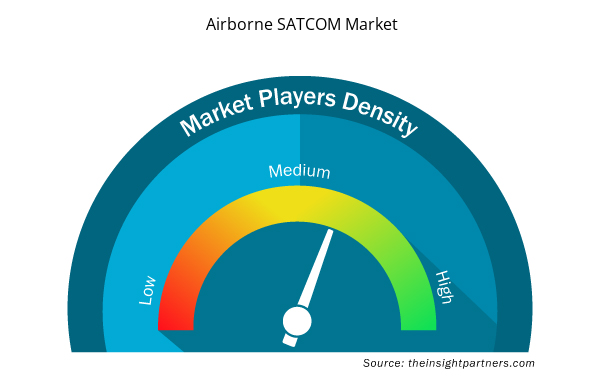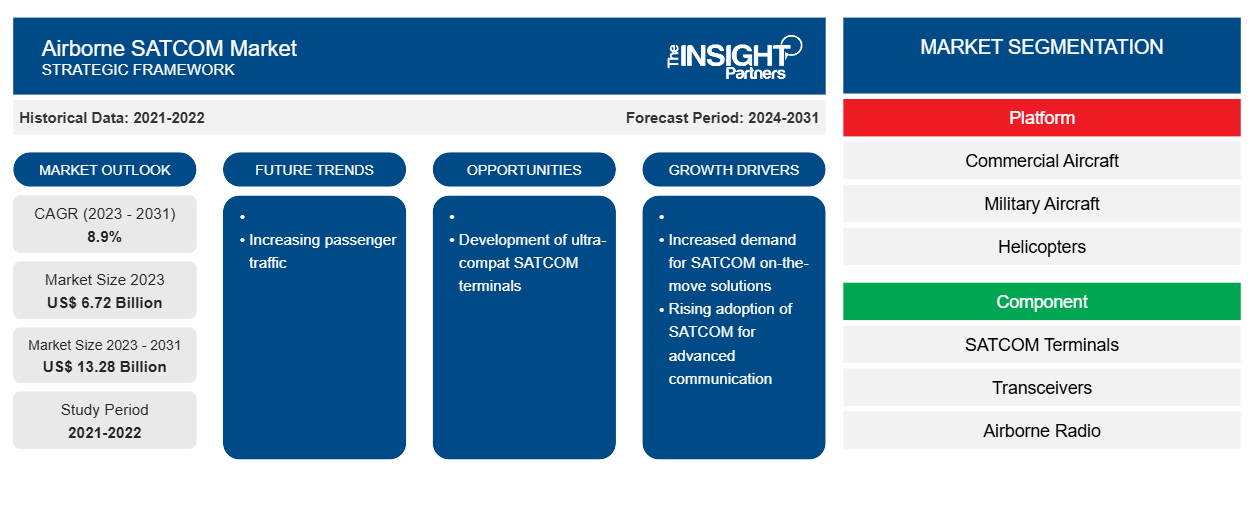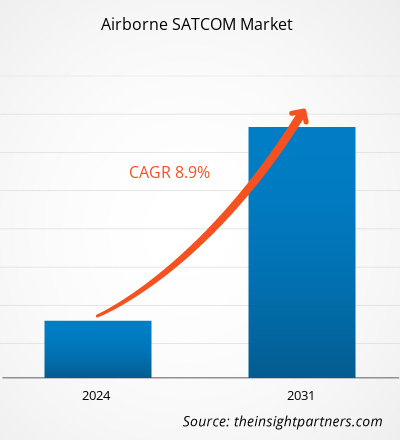机载卫星通信市场规模预计将从 2023 年的 67.2 亿美元增至 2031 年的 132.8 亿美元。预计 2023-2031 年期间市场复合年增长率将达到 8.9%。航空客运量增加可能仍是市场的主要趋势。
机载卫星通信市场分析
机载卫星通信参与者包括柯林斯宇航、霍尼韦尔国际公司、通用动力任务系统公司、L3哈里斯技术公司、维萨特公司、Astronics 公司等等。机载卫星通信市场有大量小型企业参与其中,占据了全球市场的很大份额。小型企业还参与新技术的研发活动,这些新技术将在未来几年进一步扩大市场规模。多年来,在政府监管机构的帮助下,这些组织根据日益增长的客户需求,加大了对新型先进机载卫星通信开发的投资。政府监管机构通过与国防、机场和政府部门签订合同来帮助机载卫星通信制造商。
机载卫星通信市场概览
全球机载卫星通信市场生态系统的主要利益相关者包括原材料/零部件供应商、机载卫星通信制造商、政府监管机构和最终用户。原材料/零部件供应商是机载卫星通信市场生态系统中的关键利益相关者。卫星通信中使用的主要原材料包括发射器、接收器、收发器、天线、机载无线电、调制解调器和路由器、高功率放大器、电池和其他设备。所有这些零部件的及时供应对于整个机载卫星通信制造厂的高效运营至关重要。因此,对这些零部件供应商的任何运营影响都会直接影响机载卫星通信市场。
定制此报告以满足您的需求
您可以免费定制任何报告,包括本报告的部分内容、国家级分析、Excel 数据包,以及为初创企业和大学提供优惠和折扣
- 获取此报告的关键市场趋势。这个免费样品将包括数据分析,从市场趋势到估计和预测。
机载卫星通信市场驱动因素和机遇
对 SATCOM 移动通信 (OTM) 解决方案的需求增加
卫星通信技术最重要的应用之一是移动通信 (COTM),它为各种企业提供关键服务。COTM 为军事和商业终端用户提供急救、灾难恢复、应急准备、远程访问和其他应用的重要应用。此外,配备卫星天线的移动飞机(例如商用、政府和无人驾驶飞行器 (UAV))在飞行过程中能够与卫星网络建立并维持通信,这些被称为 COTM。对基于卫星的移动通信 (COTM) 的需求已成为国防和商业空中通信系统的新趋势。由于最初为安全和国防行业设计的带有低增益天线解决方案的高功率 L 波段卫星的出现,COTM 技术变得更加有效。2018 年 11 月,Get SAT 宣布推出用于移动 L 波段机载应用的 UltraBlade L 波段天线。商业和军事客户和运营商都希望获得更快的速度和更具竞争力的带宽价格。由于不同平台需要新的天线类型或购买连接的方式,运营商的网络受到限制,从而导致了先进的机载移动卫星通信解决方案的发展。
超小型卫星通信终端的开发
具有战术远程能力的无人机用于获取实时情报、监视和侦察 (ISR) 数据并将其传输到地面站。可靠的高性能卫星通信可确保超视距 (BLOS) 活动中的持续宽带连接。近年来,对具有高性能和高吞吐量 L 波段 SATCOM 终端且占地面积小的小型飞行器 (UAV) 的需求显着增加。例如,Intellian 于 2021 年 10 月宣布其新的 FB250 和 Fleet One L 波段终端获得了 Inmarsat 型号认证。Intellian Fleet One 终端是一种小巧、坚固且低成本的解决方案,可同时进行高达 150kbps 的电话和数据通信。此外,在 2022 年 1 月,国际移动卫星通信市场领导者 Inmarsat 允许超智能和通信将其新的超紧凑 SATCOM 终端与 Inmarsat Global Xpress 网络一起使用。新型超级终端在尺寸、重量、功率和更高性能标准方面处于领先地位,创造了作战领域的通信能力,促进了战场士兵与指挥控制之间的任务关键型通信。
机载卫星通信市场报告细分分析
有助于得出机载卫星通信市场分析的关键部分是平台、组件和应用。
- 根据平台,机载卫星通信市场分为商用飞机、军用飞机、直升机和无人机。商用飞机领域在 2023 年占据了更大的市场份额。
- 根据组件,机载卫星通信市场细分为卫星通信终端、收发器、机载无线电、调制解调器和路由器、卫星通信天线罩等。收发器部分在 2023 年占据了更大的市场份额。
- 根据应用,机载卫星通信市场分为国防和商业。商业领域在 2023 年占据了更大的市场份额。
机载卫星通信市场份额(按地区)分析
机载卫星通信市场报告的地理范围主要分为五个区域:北美、欧洲、亚太、中东和非洲、南美。
2023 年,亚太地区占据了市场主导地位,其次是北美和欧洲地区。此外,亚太地区在未来几年也可能出现最高的复合年增长率。中国是亚太地区人口最多的国家之一,也是世界上最大的制造业中心之一。中国拥有波音、空客、中国商飞、普惠、昌河飞机工业公司、重庆直升机投资公司、哈尔滨飞机工业集团、宇翔国际、沈阳飞机工业公司、中航飞机公司和贵州飞机工业公司的设施。中国在飞机、无人机、直升机和其他飞机部件的制造和生产方面取得了长足的发展,并拥有完善的航空航天制造中心。例如,到 2021 年底,中国商飞宣布已在全国交付了约 66 架中国制造的飞机;空客中国公司也宣布,在同一时期,它已在全国交付了约 142 架商用飞机。
机载卫星通信市场区域洞察
Insight Partners 的分析师已详细解释了预测期内影响机载卫星通信市场的区域趋势和因素。本节还讨论了北美、欧洲、亚太地区、中东和非洲以及南美和中美洲的机载卫星通信市场细分和地理位置。

- 获取机载卫星通信市场的区域特定数据
机载卫星通信市场报告范围
| 报告属性 | 细节 |
|---|---|
| 2023 年的市场规模 | 67.2亿美元 |
| 2031 年市场规模 | 132.8亿美元 |
| 全球复合年增长率(2023 - 2031) | 8.9% |
| 史料 | 2021-2022 |
| 预测期 | 2024-2031 |
| 涵盖的领域 | 按平台
|
| 覆盖地区和国家 | 北美
|
| 市场领导者和主要公司简介 |
|
市场参与者密度:了解其对商业动态的影响
机载卫星通信市场正在快速增长,这得益于终端用户需求的不断增长,而这些需求又源于消费者偏好的不断变化、技术进步以及对产品优势的认识不断提高等因素。随着需求的增加,企业正在扩大其产品范围,进行创新以满足消费者的需求,并利用新兴趋势,从而进一步推动市场增长。
市场参与者密度是指在特定市场或行业内运营的企业或公司的分布情况。它表明在给定市场空间中,相对于其规模或总市场价值,有多少竞争对手(市场参与者)存在。
在机载卫星通信市场运营的主要公司有:
- 阿塞尔桑 A.
- 泰雷兹集团
- 柯林斯航空航天
- 科巴姆有限公司
- 霍尼韦尔国际公司
免责声明:上面列出的公司没有按照任何特定顺序排列。

- 获取机载卫星通信市场主要参与者的概览
机载卫星通信市场新闻和最新发展
机载卫星通信市场通过收集一手和二手研究后的定性和定量数据进行评估,其中包括重要的公司出版物、协会数据和数据库。下面列出了机载卫星通信市场的一些发展情况:
- Astronics Corporation(纳斯达克股票代码:ATRO)是全球航空航天、国防和其他关键任务行业先进技术的领先供应商,该公司今天推出了 Typhon T-400 系列系统,该系统代表了下一代卫星通信 (SATCOM) 连接技术。Typhon T-400 系列旨在无缝运行在任何基于 GEO 的 Ku 卫星网络上,有效解决为飞机配备 SATCOM 连接的高成本所带来的挑战。(来源:Astronics Corporation,新闻稿,2024 年 3 月)
- 全球通信公司 Viasat Inc. (NASDAQ: VSAT) 今天宣布,它已将安全、灵活的宽带 Ku 波段和 Ka 波段机载技术集成到空客 C295 MSA 飞机上,供爱尔兰空军 (IAC) 使用,该部队是爱尔兰国防军的一个部门,专注于爱尔兰空域的军事防空和支持联合国维和行动。Viasat 和空客合作将 Viasat 灵活的双频宽带终端 GAT-5530 集成到 C295 MSA 飞机上,以增强这种多用途军用机载平台的能力。空客于今年早些时候向爱尔兰国防军交付了两架 C295 MSA 飞机。(来源:Viasat Inc.,新闻稿,2023 年 12 月)
机载卫星通信市场报告覆盖范围和交付成果
“机载卫星通信市场规模和预测(2021-2031)”报告对以下领域进行了详细的市场分析:
- 机载卫星通信市场规模以及全球、区域和国家层面所有主要细分市场的预测,涵盖范围
- 机载卫星通信市场趋势以及市场动态,如驱动因素、限制因素和关键机遇
- 详细的波特五力分析
- 机载卫星通信市场分析涵盖主要市场趋势、全球和区域框架、主要参与者、法规和最新市场发展
- 行业格局和竞争分析,涵盖市场集中度、热图分析、知名参与者以及机载卫星通信市场的最新发展
- 详细的公司简介
- 历史分析(2 年)、基准年、预测(7 年)及复合年增长率
- PEST 和 SWOT 分析
- 市场规模价值/数量 - 全球、区域、国家
- 行业和竞争格局
- Excel 数据集


- Fish Protein Hydrolysate Market
- Third Party Logistics Market
- Biopharmaceutical Contract Manufacturing Market
- Mail Order Pharmacy Market
- Retinal Imaging Devices Market
- Sandwich Panel Market
- Authentication and Brand Protection Market
- Railway Braking System Market
- Europe Tortilla Market
- Workwear Market

Report Coverage
Revenue forecast, Company Analysis, Industry landscape, Growth factors, and Trends

Segment Covered
This text is related
to segments covered.

Regional Scope
North America, Europe, Asia Pacific, Middle East & Africa, South & Central America

Country Scope
This text is related
to country scope.
常见问题
The rising adoption of satellite communication (SATCOM) technology to provide advanced communication solution and increase in demand for SATCOM On-The-Move (OTM) solutions are some of the factors driving the growth for airborne SATCOM market.
Asia Pacific region dominated the airborne SATCOM market in 2023.
Increasing air passenger traffic is one of the major trends of the market.
Collins Aerospace (Raytheon Technologies Corporation), Honeywell International Inc, General Dynamics Mission Systems Inc, L3Harris Technologies Inc, Viasat Inc, Astronics Corporation, ASELSAN AS, Thales Group, Cobham Limited, and Orbit Communications Systems Ltd are some of the key players profiled under the report.
The estimated value of the airborne SATCOM market by 2031 would be around US$ 13.27 billion.
The airborne SATCOM market is likely to register of 8.9% during 2023-2031.
Trends and growth analysis reports related to Aerospace and Defense : READ MORE..
The Insight Partners performs research in 4 major stages: Data Collection & Secondary Research, Primary Research, Data Analysis and Data Triangulation & Final Review.
- Data Collection and Secondary Research:
As a market research and consulting firm operating from a decade, we have published and advised several client across the globe. First step for any study will start with an assessment of currently available data and insights from existing reports. Further, historical and current market information is collected from Investor Presentations, Annual Reports, SEC Filings, etc., and other information related to company’s performance and market positioning are gathered from Paid Databases (Factiva, Hoovers, and Reuters) and various other publications available in public domain.
Several associations trade associates, technical forums, institutes, societies and organization are accessed to gain technical as well as market related insights through their publications such as research papers, blogs and press releases related to the studies are referred to get cues about the market. Further, white papers, journals, magazines, and other news articles published in last 3 years are scrutinized and analyzed to understand the current market trends.
- Primary Research:
The primarily interview analysis comprise of data obtained from industry participants interview and answers to survey questions gathered by in-house primary team.
For primary research, interviews are conducted with industry experts/CEOs/Marketing Managers/VPs/Subject Matter Experts from both demand and supply side to get a 360-degree view of the market. The primary team conducts several interviews based on the complexity of the markets to understand the various market trends and dynamics which makes research more credible and precise.
A typical research interview fulfils the following functions:
- Provides first-hand information on the market size, market trends, growth trends, competitive landscape, and outlook
- Validates and strengthens in-house secondary research findings
- Develops the analysis team’s expertise and market understanding
Primary research involves email interactions and telephone interviews for each market, category, segment, and sub-segment across geographies. The participants who typically take part in such a process include, but are not limited to:
- Industry participants: VPs, business development managers, market intelligence managers and national sales managers
- Outside experts: Valuation experts, research analysts and key opinion leaders specializing in the electronics and semiconductor industry.
Below is the breakup of our primary respondents by company, designation, and region:

Once we receive the confirmation from primary research sources or primary respondents, we finalize the base year market estimation and forecast the data as per the macroeconomic and microeconomic factors assessed during data collection.
- Data Analysis:
Once data is validated through both secondary as well as primary respondents, we finalize the market estimations by hypothesis formulation and factor analysis at regional and country level.
- Macro-Economic Factor Analysis:
We analyse macroeconomic indicators such the gross domestic product (GDP), increase in the demand for goods and services across industries, technological advancement, regional economic growth, governmental policies, the influence of COVID-19, PEST analysis, and other aspects. This analysis aids in setting benchmarks for various nations/regions and approximating market splits. Additionally, the general trend of the aforementioned components aid in determining the market's development possibilities.
- Country Level Data:
Various factors that are especially aligned to the country are taken into account to determine the market size for a certain area and country, including the presence of vendors, such as headquarters and offices, the country's GDP, demand patterns, and industry growth. To comprehend the market dynamics for the nation, a number of growth variables, inhibitors, application areas, and current market trends are researched. The aforementioned elements aid in determining the country's overall market's growth potential.
- Company Profile:
The “Table of Contents” is formulated by listing and analyzing more than 25 - 30 companies operating in the market ecosystem across geographies. However, we profile only 10 companies as a standard practice in our syndicate reports. These 10 companies comprise leading, emerging, and regional players. Nonetheless, our analysis is not restricted to the 10 listed companies, we also analyze other companies present in the market to develop a holistic view and understand the prevailing trends. The “Company Profiles” section in the report covers key facts, business description, products & services, financial information, SWOT analysis, and key developments. The financial information presented is extracted from the annual reports and official documents of the publicly listed companies. Upon collecting the information for the sections of respective companies, we verify them via various primary sources and then compile the data in respective company profiles. The company level information helps us in deriving the base number as well as in forecasting the market size.
- Developing Base Number:
Aggregation of sales statistics (2020-2022) and macro-economic factor, and other secondary and primary research insights are utilized to arrive at base number and related market shares for 2022. The data gaps are identified in this step and relevant market data is analyzed, collected from paid primary interviews or databases. On finalizing the base year market size, forecasts are developed on the basis of macro-economic, industry and market growth factors and company level analysis.
- Data Triangulation and Final Review:
The market findings and base year market size calculations are validated from supply as well as demand side. Demand side validations are based on macro-economic factor analysis and benchmarks for respective regions and countries. In case of supply side validations, revenues of major companies are estimated (in case not available) based on industry benchmark, approximate number of employees, product portfolio, and primary interviews revenues are gathered. Further revenue from target product/service segment is assessed to avoid overshooting of market statistics. In case of heavy deviations between supply and demand side values, all thes steps are repeated to achieve synchronization.
We follow an iterative model, wherein we share our research findings with Subject Matter Experts (SME’s) and Key Opinion Leaders (KOLs) until consensus view of the market is not formulated – this model negates any drastic deviation in the opinions of experts. Only validated and universally acceptable research findings are quoted in our reports.
We have important check points that we use to validate our research findings – which we call – data triangulation, where we validate the information, we generate from secondary sources with primary interviews and then we re-validate with our internal data bases and Subject matter experts. This comprehensive model enables us to deliver high quality, reliable data in shortest possible time.


 获取此报告的免费样本
获取此报告的免费样本